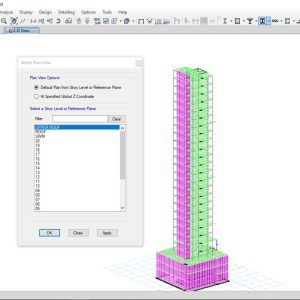Table of Contents
-
 MS Office Professional Essential Training$200.00
MS Office Professional Essential Training$200.00 -
 Primavera P6 Professional Training Course$250.00
Primavera P6 Professional Training Course$250.00 -
Product on sale
 20+ Story High Rise BuildingOriginal price was: $39.99.$9.99Current price is: $9.99.
20+ Story High Rise BuildingOriginal price was: $39.99.$9.99Current price is: $9.99. -
 CSI SAFE Essential Training Course$250.00
CSI SAFE Essential Training Course$250.00 -
 CSI ETABS Essential Training Course$350.00
CSI ETABS Essential Training Course$350.00
1. Introduction to Structural Steel Design
1.1 Advantages of Steel as a Structural Material
1.2 Disadvantages of Steel as a Structural Material
1.3 Early Uses of Iron and Steel
1.4 Steel Sections
1.5 Metric Units
1.6 Cold-Formed Light-Gage Steel Shapes
1.7 Stress—Strain Relationships in Structural Steel
1.8 Modern Structural Steels
1.9 Uses of High-Strength Steels
1.10 Measurement of Toughness
1.11 Jumbo Sections
1.12 Lamellar Tearing
1.13 Furnishing of Structural Steel
1.14 The Work of the Structural Designer
1.15 Responsibilities of the Structural Designer
1.16 Economical Design of Steel Members
1.17 Failure of Structures
1.18 Handling and Shipping Structural Steel
1.19 Calculation Accuracy
1.20 Computers and Structural Steel Design
1.21 Problems for Solution
2. Specifications, Loads, and Methods of Design
2.1 Specifications and Building Codes
2.2 Loads
2.3 Dead Loads
2.4 Live Loads
2.5 Environmental Loads
2.6 Load and Resistance Factor Design (LRFD) and Allowable Strength Design (ASD)
2.7 Nominal Strengths
2.8 Shading
2.9 Computation of Loads for LRFD and ASD
2.10 Computing Combined Loads with LRFD Expressions
2.11 Computing Combined Loads with ASD Expressions
2.12 Two Methods of Obtaining an Acceptable Level of Safety
2.13 Discussion of Sizes of Load Factors and Safety Factors
2.14 Author’s Comment
2.15 Examples with Video Solution
2.16 Problems for Solution
3. Analysis of Tension Members
3.1 Introduction
3.2 Nominal Strengths of Tension Members
3.3 Net Areas
3.4 Effect of Staggered Holes
3.5 Effective Net Areas
3.6 Connecting Elements for Tension Members
3.7 Block Shear
3.8 Examples with Video Solution
3.9 Problems for Solution
4. Design of Tension Members
4.1 Selection of Sections
4.2 Built-Up Tension Members
4.3 Rods and Bars
4.4 Pin-Connected Members
4.5 Design for Fatigue Loads
4.6 Examples with Video Solution
4.7 Problems for Solution
5. Introduction to Axially Loaded Compression Members
5.1 General
5.2 Residual Stresses
5.3 Sections Used for Columns
5.4 Development of Column Formulas
5.5 The Euler Formula
5.6 End Restraint and Effective Lengths of Columns
5.7 Stiffened and Unstiffened Elements
5.8 Long, Short, and Intermediate Columns
5.9 Column Formulas
5.10 Maximum Slenderness Ratios
5.11 Example Problems
5.12 Examples with Video Solution
5.13 Problems for Solution
6. Design of Axially Loaded Compression Members
6.1 Introduction
6.2 AISC Design Tables
6.3 Column Splices
6.4 Built-Up Columns
6.5 Built-Up Columns with Components in Contact with Each Other
6.6 Connection Requirements for Built-Up Columns Whose Components Are in Contact with Each Other
6.7 Built-Up Columns with Components Not in Contact with Each Other
6.8 Single-Angle Compression Members
6.9 Sections Containing Slender Elements
6.10 Flexural-Torsional Buckling of Compression Members
6.11 Examples with Video Solution
6.12 Problems for Solution
7. Design of Axially Loaded Compression Members (Continued) and Column Base Plates
7.1 Introduction
7.2 Further Discussion of Effective Lengths
7.3 Frames Meeting Alignment Chart Assumptions
7.4 Frames Not Meeting Alignment Chart Assumptions As to Joint Rotations
7.5 Stiffness-Reduction Factors
7.6 Columns Leaning on Each Other for In-Plane Design
7.7 Base Plates for Concentrically Loaded Columns
7.8 Examples with Video Solution
7.9 Problems for Solution
8. Introduction to Beams
8.1 Types of Beams
8.2 Sections Used as Beams
8.3 Bending Stresses
8.4 Plastic Hinges
8.5 Elastic Design
8.6 The Plastic Modulus
8.7 Theory of Plastic Analysis
8.8 The Collapse Mechanism
8.9 The Virtual-Work Method
8.10 Location of Plastic Hinge for Uniform Loadings
8.11 Continuous Beams
8.12 Building Frames
8.13 Examples with Video Solution
8.14 Problems for Solution
9. Design of Beams for Moments
9.1 Introduction
9.2 Yielding Behavior–Full Plastic Moment, Zone 1
9.3 Design of Beams, Zone 1
9.4 Lateral Support of Beams
9.5 Introduction to Inelastic Buckling, Zone 2
9.6 Moment Capacities, Zone 2
9.7 Elastic Buckling, Zone 3
9.8 Design Charts
9.9 Noncompact Sections
9.10 Examples with Video Solution
9.11 Problems for Solution
10. Design of Beams–Miscellaneous Topics (Shear, Deflection, etc.)
10.1 Design of Continuous Beams
10.2 Shear
10.3 Deflections
10.4 Webs and Flanges with Concentrated Loads
10.5 Unsymmetrical Bending
10.6 Design of Purlins
10.7 The Shear Center
10.8 Beam-Bearing Plates
10.9 Lateral Bracing at Member Ends Supported on Base Plates
10.10 Examples with Video Solution
10.11 Problems for Solution
11. Bending and Axial Force
11.1 Occurrence
11.2 Members Subject to Bending and Axial Tension
11.3 First-Order and Second-Order Moments for Members Subject to Axial Compression and Bending
11.4 Direct Analysis Method (DAM)
11.5 Effective Length Method (ELM)
11.6 Approximate Second-Order Analysis
11.7 Beam—Columns in Braced Frames
11.8 Beam—Columns in Unbraced Frames
11.9 Design of Beam—Columns–Braced or Unbraced
11.10 Examples with Video Solution
11.11 Problems for Solution
12. Bolted Connections
12.1 Introduction
12.2 Types of Bolts
12.3 History of High-Strength Bolts
12.4 Advantages of High-Strength Bolts
12.5 Snug-Tight, Pretensioned, and Slip-Critical Bolts
12.6 Methods for Fully Pretensioning High-Strength Bolts
12.7 Slip-Resistant Connections and Bearing-Type Connections
12.8 Mixed Joints
12.9 Sizes of Bolt Holes
12.10 Load Transfer and Types of Joints
12.11 Failure of Bolted Joints
12.12 Spacing and Edge Distances of Bolts
12.13 Bearing-Type Connections–Loads Passing Through Center of Gravity of Connections
12.14 Slip-Critical Connections–Loads Passing Through Center of Gravity of Connections
12.15 Examples with Video Solution
12.16 Problems for Solution
13. Eccentrically Loaded Bolted Connections and Historical Notes on Rivets
13.1 Bolts Subjected to Eccentric Shear
13.2 Bolts Subjected to Shear and Tension (Bearing-Type Connections)
13.3 Bolts Subjected to Shear and Tension (Slip-Critical Connections)
13.4 Tension Loads on Bolted Joints
13.5 Prying Action
13.6 Historical Notes on Rivets
13.7 Types of Rivets
13.8 Strength of Riveted Connections–Rivets in Shear and Bearing
13.9 Examples with Video Solution
13.10 Problems for Solution
14. Welded Connections
14.1 General
14.2 Advantages of Welding
14.3 American Welding Society
14.4 Types of Welding
14.5 Prequalified Welding
14.6 Welding Inspection
14.7 Classification of Welds
14.8 Welding Symbols
14.9 Groove Welds
14.10 Fillet Welds
14.11 Strength of Welds
14.12 AISC Requirements
14.13 Design of Simple Fillet Welds
14.14 Design of Connections for Members with Both Longitudinal and Transverse Fillet Welds
14.15 Some Miscellaneous Comments
14.16 Design of Fillet Welds for Truss Members
14.17 Plug and Slot Welds
14.18 Shear and Torsion
14.19 Shear and Bending
14.20 Full-Penetration and Partial-Penetration Groove Welds
14.21 Examples with Video Solution
14.22 Problems for Solution
15. Building Connections
15.1 Selection of Type of Fastener
15.2 Types of Beam Connections
15.3 Standard Bolted Beam Connections
15.4 AISC Manual Standard Connection Tables
15.5 Designs of Standard Bolted Framed Connections
15.6 Designs of Standard Welded Framed Connections
15.7 Single-Plate, or Shear Tab, Framing Connections
15.8 End-Plate Shear Connections
15.9 Designs of Welded Seated Beam Connections
15.10 Designs of Stiffened Seated Beam Connections
15.11 Designs of Moment-Resisting FR Moment Connections
15.12 Column Web Stiffeners
15.13 Problems for Solution
16. Composite Beams
16.1 Composite Construction
16.2 Advantages of Composite Construction
16.3 Discussion of Shoring
16.4 Effective Flange Widths
16.5 Shear Transfer
16.6 Partially Composite Beams
16.7 Strength of Shear Connectors
16.8 Number, Spacing, and Cover Requirements for Shear Connectors
16.9 Moment Capacity of Composite Sections
16.10 Deflections
16.11 Design of Composite Sections
16.12 Continuous Composite Sections
16.13 Design of Concrete-Encased Sections
16.14 Problems for Solution
17. Composite Columns
17.1 Introduction
17.2 Advantages of Composite Columns
17.3 Disadvantages of Composite Columns
17.4 Lateral Bracing
17.5 Specifications for Composite Columns
17.6 Axial Design Strengths of Composite Columns
17.7 Shear Strength of Composite Columns
17.8 LRFD and ASD Tables
17.9 Load Transfer at Footings and Other Connections
17.10 Tensile Strength of Composite Columns
17.11 Axial Load and Bending
17.12 Problems for Solution
18. Cover-Plated Beams and Built-up Girders
18.1 Cover-Plated Beams
18.2 Built-up Girders
18.3 Built-up Girder Proportions
18.4 Flexural Strength
18.5 Tension Field Action
18.6 Design of Stiffeners
18.7 Problems for Solution
19. Design of Steel Buildings
19.1 Introduction to Low-Rise Buildings
19.2 Types of Steel Frames Used for Buildings
19.3 Common Types of Floor Construction
19.4 Concrete Slabs on Open-Web Steel Joists
19.5 One-Way and Two-Way Reinforced-Concrete Slabs
19.6 Composite Floors
19.7 Concrete-Pan Floors
19.8 Steel Floor Deck
19.9 Flat Slab Floors
19.10 Precast Concrete Floors
19.11 Types of Roof Construction
19.12 Exterior Walls and Interior Partitions
19.13 Fireproofing of Structural Steel
19.14 Introduction to High-Rise Buildings
19.15 Discussion of Lateral Forces
19.16 Types of Lateral Bracing
19.17 Analysis of Buildings with Diagonal Wind Bracing for Lateral Forces
19.18 Moment-Resisting Joints
19.19 Design of Buildings for Gravity Loads
19.20 Selection of Members
APPENDIX A Derivation of the Euler Formula
APPENDIX B Slender Compression Elements
APPENDIX C Flexural-Torsional Buckling of Compression Members
APPENDIX D Moment-Resisting Column Base Plates
APPENDIX E Ponding
GLOSSARY
INDEX
-
 Turnitin Instructor with AI Detection$70.00 – $130.00
Turnitin Instructor with AI Detection$70.00 – $130.00 -
 SmartPLS 4.1 Processional | Lifetime activation key$60.00
SmartPLS 4.1 Processional | Lifetime activation key$60.00 -
 EndNote Lifetime for Windows /Mac Software Full Version$8.00 – $15.00
EndNote Lifetime for Windows /Mac Software Full Version$8.00 – $15.00 -
![Structural Steel Design by Jack C McCormac (Textbook + Solution Manual) 11 IBM SPSS Statistics v30 | v29 [Lifetime Activation with key]](https://civilmdc.com/wp-content/uploads/2022/03/IBM-SPSS-30-Key-300x300.jpg) IBM SPSS Statistics v30 | v29 [Lifetime Activation with key]$15.00 – $45.00
IBM SPSS Statistics v30 | v29 [Lifetime Activation with key]$15.00 – $45.00 -
 LinkedIn ALL COURSES LIFETIME Warranty$25.00
LinkedIn ALL COURSES LIFETIME Warranty$25.00 -
Product on sale
 REF-N-WRITE | Premium Account Lifetime ActivationOriginal price was: $45.00.$22.00Current price is: $22.00.
REF-N-WRITE | Premium Account Lifetime ActivationOriginal price was: $45.00.$22.00Current price is: $22.00. -
 QuillBot’s paraphrasing tool | Premium Account 6 month | + WARRANTY$12.00
QuillBot’s paraphrasing tool | Premium Account 6 month | + WARRANTY$12.00 -
 Grammarly Premium Account 6 Month |12 month$20.00 – $35.00
Grammarly Premium Account 6 Month |12 month$20.00 – $35.00 -
 TURNIT1N Student (Plagiarism Checker) – 6 Month | 1 Year | 2 Years | 3 Years | 4 Years | LifeTime$15.00 – $200.00
TURNIT1N Student (Plagiarism Checker) – 6 Month | 1 Year | 2 Years | 3 Years | 4 Years | LifeTime$15.00 – $200.00




 Visit
Visit 
Solution manual is not available in the link #Admin
Thank you very much
no longer available
LINK UPDATED, PLEASE CHECK NOW
Hi, I click in download now, and the drive dont have the solution manual of the 5th edition, only the 4th edition! It’s the same solution manual?
Hi, you only have the solutionary manual of the 4th edition?? thanks
Hi,
Solution Manual is present in the above Download link
no longer available
link updated,
Please check
muchas muchas gracias, me sirvió bastante.
tanks!!
Welcome